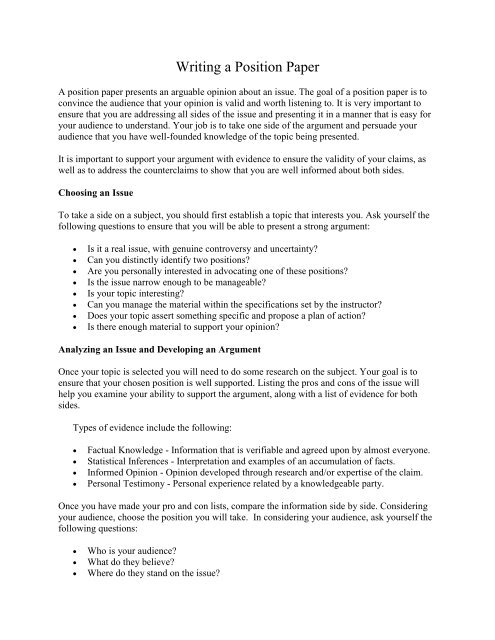
What is a position paper?
A proper includes deep research, facts, ideas, proves, links, quotations. Third, follow the rules and format of the work. Don't just handle a piece of paper filled with text, divide them into several important parts, like thesis, introduction, conclusion. Fourth, check the spelling and grammar WRITING A POSITION PAPER The following material explains how to produce a position paper (sometimes called a point of view paper). A template is provided that outlines the major parts of a good position paper. Keep in mind, however, that this is just a guide. Talk to your TAs about their individual expectations · Position papers don’t need to go into excessive detail. Present your points clearly and briefly. Each paragraph in the paper should discuss a single idea. Have someone proofread your paper to ensure it reads well and looks professional. A position paper can be a great way to expand your horizons and write a new type of research paper

How Do I Structure a Position Paper?
· Position papers don’t need to go into excessive detail. Present your points clearly and briefly. Each paragraph in the paper should discuss a single idea. Have someone proofread your paper to ensure it reads well and looks professional. A position paper can be a great way to expand your horizons and write a new type of research paper · Steps in Writing a Position Paper 1. Analyze an issue and make a stand. Choose an issue open to arguments. It should not be too general nor too specific that no supporting evidence can be made. Once the issue has been selected, do comprehensive research and investigation. Explore all sides of the issue A proper includes deep research, facts, ideas, proves, links, quotations. Third, follow the rules and format of the work. Don't just handle a piece of paper filled with text, divide them into several important parts, like thesis, introduction, conclusion. Fourth, check the spelling and grammar

Navigation menu
A proper includes deep research, facts, ideas, proves, links, quotations. Third, follow the rules and format of the work. Don't just handle a piece of paper filled with text, divide them into several important parts, like thesis, introduction, conclusion. Fourth, check the spelling and grammar · Steps in Writing a Position Paper 1. Analyze an issue and make a stand. Choose an issue open to arguments. It should not be too general nor too specific that no supporting evidence can be made. Once the issue has been selected, do comprehensive research and investigation. Explore all sides of the issue Position papers range from the simplest format of a letter to the editor, through to the most complex in the form of an academic position paper. Position papers are also used by large organizations to make public the official beliefs and recommendations of the group. Contents 1 In academia 2 In politics 3 In law 4 Notes 5 References

How Do I Select a Good Topic for My Position Paper?
A proper includes deep research, facts, ideas, proves, links, quotations. Third, follow the rules and format of the work. Don't just handle a piece of paper filled with text, divide them into several important parts, like thesis, introduction, conclusion. Fourth, check the spelling and grammar · Below is a guideline to use as an example when composing a position paper. 1. Introduction Topic introduction Background information Thesis statement 2. Body Paragraphs Counter argument – Supporting evidence – Refute counter-claims – State your argument with evidence Your perspective – Present your opinion – Evidence – Reliable resources 3 · Position papers don’t need to go into excessive detail. Present your points clearly and briefly. Each paragraph in the paper should discuss a single idea. Have someone proofread your paper to ensure it reads well and looks professional. A position paper can be a great way to expand your horizons and write a new type of research paper

· Steps in Writing a Position Paper 1. Analyze an issue and make a stand. Choose an issue open to arguments. It should not be too general nor too specific that no supporting evidence can be made. Once the issue has been selected, do comprehensive research and investigation. Explore all sides of the issue A proper includes deep research, facts, ideas, proves, links, quotations. Third, follow the rules and format of the work. Don't just handle a piece of paper filled with text, divide them into several important parts, like thesis, introduction, conclusion. Fourth, check the spelling and grammar · Position papers don’t need to go into excessive detail. Present your points clearly and briefly. Each paragraph in the paper should discuss a single idea. Have someone proofread your paper to ensure it reads well and looks professional. A position paper can be a great way to expand your horizons and write a new type of research paper
No comments:
Post a Comment